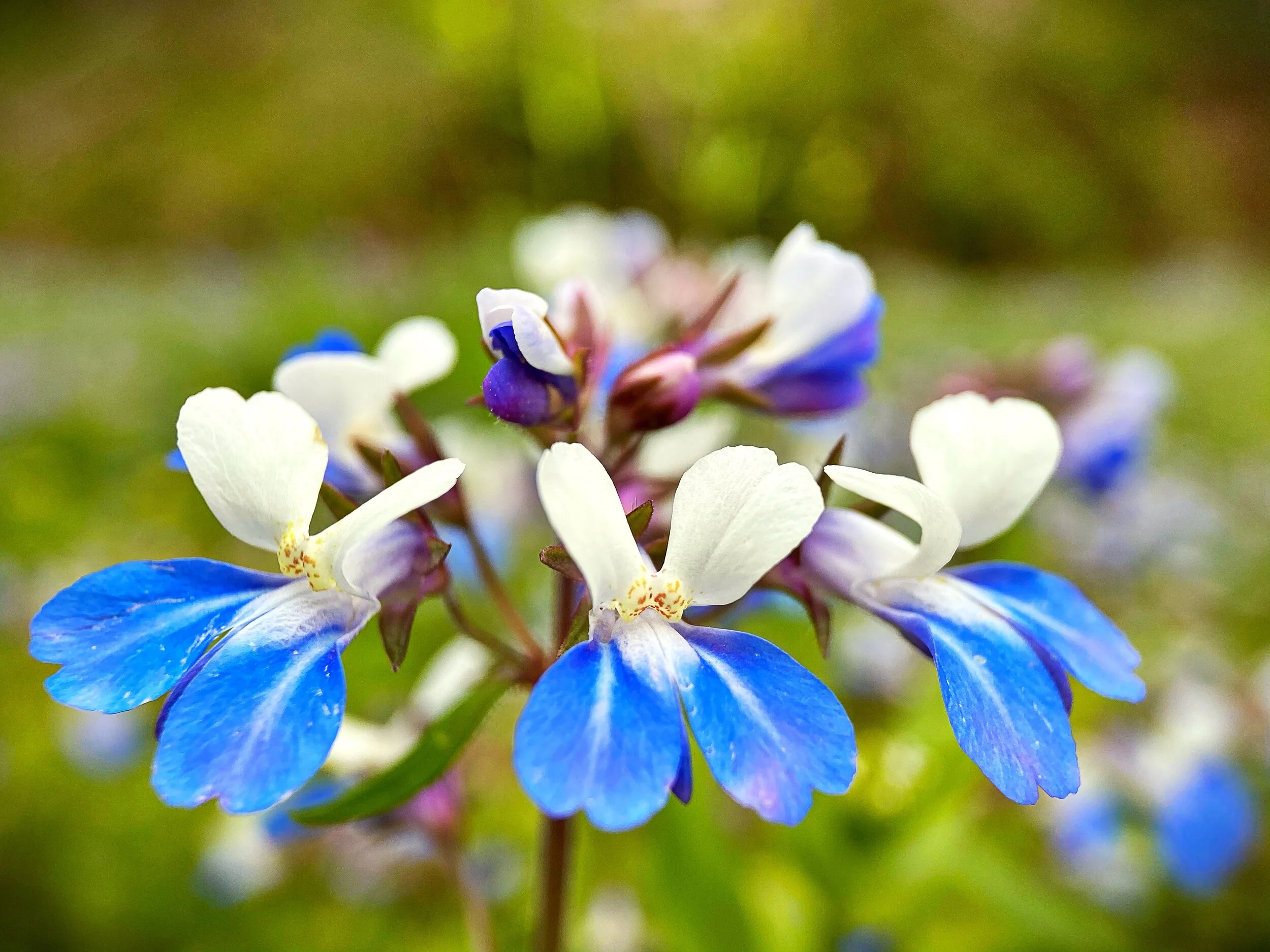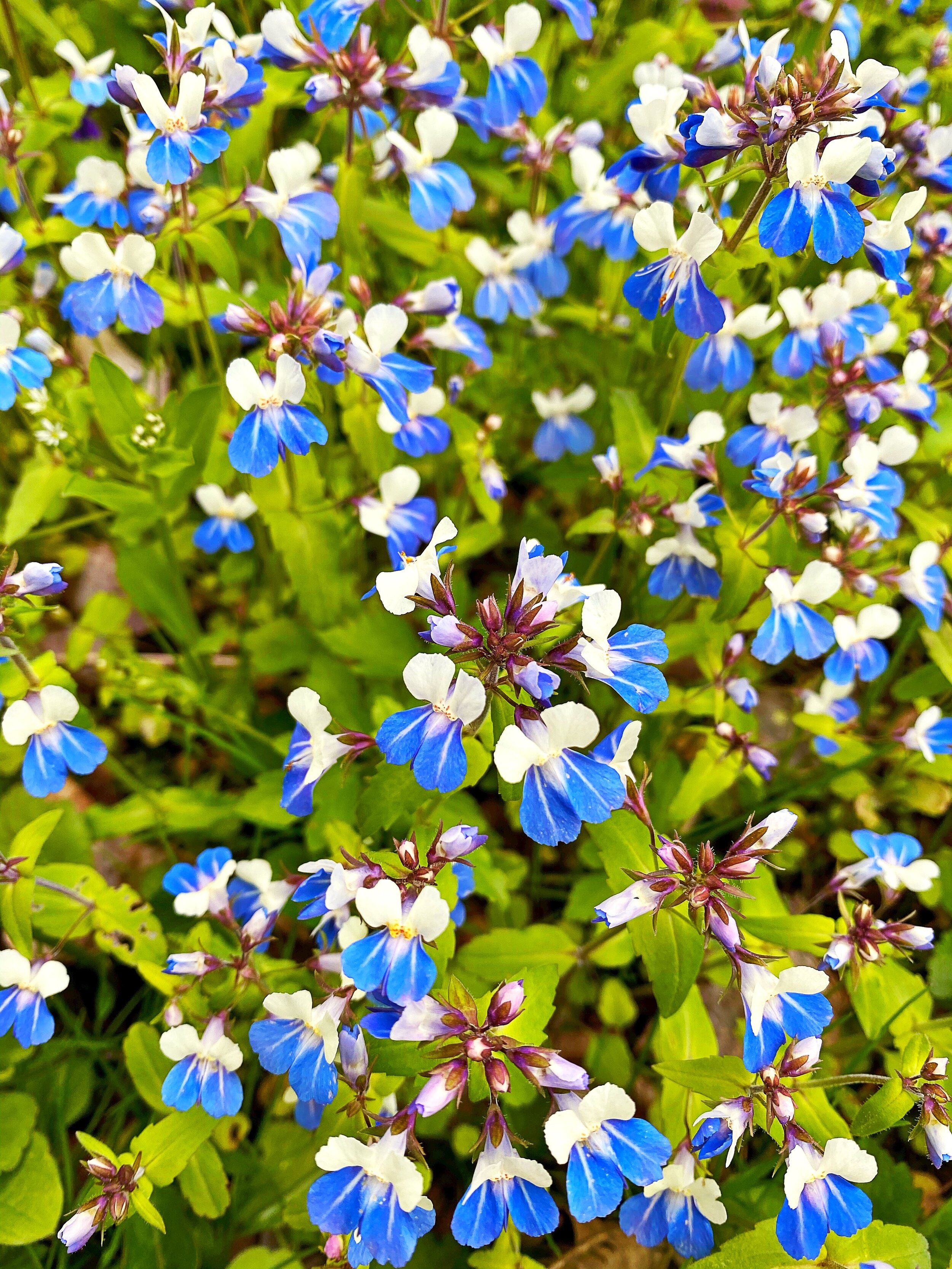A Sacred Time of Year.
Benevolence. It is the only word I can utter that comes close to describing the vision before me and the feelings it has evoked within my heart. Indescribable shades of blues and whites, like those of clear spring skies and cumulus clouds, have carpeted the forest floor and I can barely hear the breeze over the buzzing jubilation of mason bees and honey bees dancing from bloom to bloom.
The flowering of the Blue-eyed Marys (Collinsia verna) has arrived, marking a most sacred time of year - it is the season of a waking forest with its wildflowers and morel mushrooms that arrive and disappear in the rush of late April’s lustrous fertility. To say they are my favorite of this forest’s expressions is an understatement, as ‘favorite’ invites an air of hierarchical judgment or preference.
Rather, there is no other sight in these feral woodlands of Southeast Ohio that makes me feel the way that Blue-eyed Marys do. It is the warming of unconditional acceptance…like being held in the arms of Mother Nature herself as she kisses me on my forehead to remind me that I am worthy of her love.
The dreamy landscape of Blue-eyed Mary (Collinsia verna). Photo: Erika Galentin, May 2020. Hocking County, OH.
A Cycle of Kindness: Blue-eyed Mary’s Journey as a Winter Annual
Like all flowering plants, life for the Blue-eyed Mary begins as a seed. Borne of blooms from mid-April through mid-May, these seeds are mature and passively dispersed by the parent plant before the Summer Solstice arrives. Upon the warm ground they wait for autumn to coax out their germination. If they don’t germinate, the tiny little seeds can remain viable in the soil for up to four years.[i][ii]
By early winter, very small, very tender plants have sprouted on the cooling forest floor. And there they shall remain, stunted in their growth, freezing and thawing through Ohio’s unpredictable winter until they are finally released by the following Spring Equinox. This lifecycle places the Blue-eyed Marys in the category of winter annuals, a term that identifies the unusual rhythm of plants that germinate in the fall and capably overwinter in a tender state.
Young seedlings of Blue-eyed Mary. There is such bravery in their endurance, much like that found in true friendship. Photo by Erika Galentin, December 2019. Hocking County, OH.
Native range of Blue-eyed Mary. Collinsia verna. Source: USDA, NRCS Plants Profile Database.
Although Blue-eyed Mary’s range is extensive, stretching west from New York to Michigan and Iowa, south through Missouri, Oklahoma, and Arkansas, and all the way up to the northern reaches of Quebec, the extreme south- and northeast of the United States remain outside of its native territory.[iii]
The species thrives in floodplain forests and moist woodland bottoms where the soil is rich and in close proximity to fresh water. Substantial populations, estimated somewhere close to 20,000,000,[iv] like to follow along creek beds and river courses, whimsically decorating their banks. Some ecologists who have studied this species believe these water ways to be important vectors of population growth and spread, whereby floating seeds travel down winding creeks and rivers to land in fertile soil further downstream.[v] In the decade I have been observing this population expand in our bottomland hollow, I too have come to believe in flowing water as an important seed disperser.
When considering the prolific nature of the population before me, one could be easily fooled into believing this species status in the wild is ‘safe’. However, habitat fragmentation, the colonization of forested land for agriculture, and other anthropogenic disturbances have upset the species balance especially at the extremes of its native range. It is now considered endangered in both New York[vi] and Tennessee[vii] and extirpated from Ontario.[viii]
A small portion of a population of Blue-eyed Mary growing along a woodland creek. Photo: Erika Galentin, April 2020. Hocking County, OH.
The sinescing flowers and developing seed pods. Photo: Erika Galentin, May 2020. Hocking County, OH.
A Shade of Blue Like No Other…
During their heyday season, the blooms of Blue-eyed Marys grow on a centralized lime-green, softly pubescent, unbranched stem, never reaching taller than ten to twelve inches. Broadly lance-shaped leaves grow opposite off its axis, paving the way for a terminal whorl of anywhere between two and six asymmetrical flowers with virgin-white upper lips and lower lips of the deepest azure blue. These flowers are frequently visited by many species of native bees, as well as honeybees, to whom they provide an ample nectar source during an early spring dearth.
Pollinators are important for this species success, but not exactly necessary. In fact, in a process called ‘selfing’, the flowers of Blue-eyed Marys easily pollinate themselves.[ix] Although this is not ideal for maintaining genetic diversity, it is a powerful safe-mode way of ensuring new seeds and therefore, new young ones, sprout with the coming autumn.[x]
A honeybee enjoying Blue-eyed Mary nectar. Photo: Erika Galentin, May 2020. Hocking County, OH.
It is not easy to describe the beauty of these flowers. Their countenance is one of innocence (the species’ other common name), like that found in a child’s eyes; it is the honest gaze of unknowing that comes with being freshly borne of creation. They bear a shade of blue unlike any other I have witnessed in the plant kingdom; a blue so unique, so alluring, it is as if it reaches deeply into my psyche and changes my perceptions of the world around me…and of myself…for the better.
And this is how, I believe, the medicine of the species manifests...
Medicine is in the Eye of the Beholder
As a member of Plantaginaceae, a plant family renown for innumerable edible and medicinal species, an herbalist like myself might assume that one could procure a physical remedy from Blue-eyed Marys – one made into teas or tinctures, for example. Intrigued, I have deeply researched for any traditional or historical medicinal use, but this specific Collinsia species appears to be devoid of any ethnobotanical or historical medicinal written record. However, its cousins Collinsia parviflora and Collinsia violacea, do appear to have some traditional use specifically in regards to their roots and the respiratory system.
However, as a nature mystic, I have always been fascinated by the possibility that plant medicine comes to us in many forms, not just those of physical medicaments. Symbolic medicine, or the medicine of metaphor, can be both powerful and effective; in the case of Blue-eyed Marys it comes from the sense of calm and compassion received from their heavenly blue flowers. As if sourced from a holy place, they herald a message of affection and a desire to promote happiness. With these gifts they ask my heart to perceive my own disposition to do good - their presence a symbol of selfless acts of kindness, collaboration, and true friendship.
A symbol of selfless acts of kindness, collaboration, and true friendship. Photo: Erika Galentin, May 2020. Hocking County, OH.
Inspired by the heavenly augury of Blue-eyed Mary, we have created a flower essence for Benevolence. This essence lets you see the world with softer eyes. It is indicated for those seeking kindness within, towards themselves and others. You can shop this flower essence, as well as others in our native flower essence line, here.
References
[i] Schwartz, M. 2012. Conservation in Highly Fragmented Landscapes. New York, NY: Springer Science & Business Media.
[ii] Kalisz, K. 1991. Experimental determination of seed bank age structure in the winter annual Collinsia verna. Ecology, 72(2), 575-585. doi:10.2307/2937197
[iii] USDA, NRCS Plants Database. Collinsia verna. Online at: https://plants.usda.gov/core/profile?symbol=COVE2. Accessed April 2020.
[iv] Schwartz (2012). Ibid.
[v] Schwartz (2012). Ibid.
[vi] New York Flora Atlas of the New York Flower Association. Collinsia verna. Online at: http://newyork.plantatlas.usf.edu/Plant.aspx?id=2935. Accessed April 2020.
[vii] Schwartz (2012). Ibid.
[viii] Ministry of the Environment, Conservation and Parks. Ontario. Collinsia verna. Online at: https://www.ontario.ca/page/spring-blue-eyed-mary. Accessed April 2020.
[ix] Kalisz, S. & Vogler, D.W. 2003. Benefits of autonomous selfing under unpredictable pollinator environments. Ecology, 84(11), 2928-2942. doi:10.1890/02-0519
[x] Spigler, R.B. & Kalisz, S. 2013. Phenotypic plasticity in mating-system traits in the annual Collinsia verna. Botany, 91(9), 597-604, https://doi.org/10.1139/cjb-2012-0227








